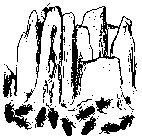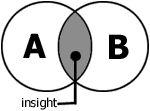
Lessons from the Edge
“New Ways of Thinking about Organization and Managing Change”
In which Gareth Morgan helped participants to
look at their organizations afresh through the metaphor of complexity.
Gareth Morgan, PhD, Distinguished Research Professor, York University
A critical point to keep in mind:
- Remember: “Leadership
and management is complicated, but simple rules may suffice. OR:
The new style organization is complicated, but simple rules may suffice.”
Can health care reinvent itself? (The termite metaphor)

- We are creating the health
care system of the future without knowing what it will look like!
- How can we facilitate this
reinvention of health care?
- The process of doing this is like termites building a termite nest or mound. In the tropics, these mounds rise to 20, 25 ft. in height. They are temperature and humidity controlled, yet there is no master plan. The order emerges from chaos. The termites seem to have a vision of their future. Some mounds emerge as columns; some columns will come together to form arches. A free-form architecture occurs, but at any time it’s impossible to know what is being built.
Metaphor plays an important role in the process!

- “It’s all metaphor!”
Our discussion of complexity theory is really just a metaphor
that can help us think in new ways.
- Be careful: All
metaphors carry strengths and weaknesses. In metaphor, we say “A is
B.” (e.g., “the health care industry is a termite nest.”) Of course,
A is not really B. Rather, we focus on A to reveal insights about
B. The overlapped area is the insight that happens when you make these
connections.
- Equally important,
there are many ways in which A is not like B (that is, health
care is not like a termite nest.)
- Critical questions
to ask yourself:
- Can you reinvent health care by getting a critical mass going that involves others?
- Can you begin developing the new system using the termite metaphor?
- How about
a different metaphor? (“Not THE metaphor, but A metaphor,”
Morgan emphasized.)
Four key themes you should know in managing change:
- Nurture emergence.
Organizations can’t be organized anymore! We must become skilled
in facilitating self-organization, the art of emergence, like termites.
- Learn
to flow with change. Don’t get too caught
up in “creating a plan.” Often, we get buried in paper, and unwittingly
create a plan that generates its own resistance!
The 15% principle suggests that we are only able to control or influence about 15% of what happens. The other 85% is out of our control! Do you know where your 15% is? If you don’t, you can’t use it. The only way to change an organization is to find the 15% leverage point that enables you to nudge the organization into a new direction. Most organizations are overwhelmed by looking at the apparently unmanageable 85%. Instead, get everyone looking for their 15% and you get a transformative impact. Small changes, large effects—that’s the Butterfly Effect at work.
- Practice the
art of managing context. To illustrate this principle, Morgan displayed
a picture of a man on his knees looking up to the sky, arms outstretched,
with a crowd of people around him. Everyone agreed this must be a picture
of a religious evangelist, leading his “flock” in prayer.
Morgan then showed another picture. It was nearly identical to the first, but the man was now balancing a flower pot on a rod on the end of his nose. With this small visual change, the “evangelist” suddenly appeared to be a “circus performer.” This was an example of changing the context.
We must become adept at doing this in a way that will allow self-organization to occur. You can’t design the new form. But you can create safe ways of flipping the context. The art of managing context rests on two activities— creating new understandings and finding new actions that will flip the situation.
In politically charged situations, you have to flip the context so people can find transformative actions.
One technique for changing the context is minspecs, or using minimum rules or points of reference that act as key attractors. Bureaucracies are defined to the limit. Everything is MaxSpecs. To facilitate emergence, focus on the few, simple rules that create the framework in which the system can find its new form. This is the manager’s job.
What are the absolutely critical parameters that must be articulated and encoded into the organizational DNA? What are your minspecs for health care systems that create an environment that allows health care to self-organize in all situations?
- Understand
the key role of contradiction. Contradiction
is part of reality. Your organization may have laid out flawless plans
for change, but it will almost certainly hit contradiction—a “but” that
prevents it from reaching its goal. Imagine these “buts” as forks in
the road that lead you in a completely different direction; in complexity
science, this is known as a bifurcation point.
Any complex system will encounter these “buts” or bifurcation points. But when they’re unprepared to meet them in the road, the organization starts going back to its initial configuration.
When you run into “buts” or contradiction, here are some management principles:- Use the 15% to create new situations that change the context
- Use minspecs to make change
- Look for the 15% in the systems’ contradictions. Paradoxes stop us, but creativity finds new ways to overcome them. Use paradox as a leverage point rather than letting it derail the effort.
Copyright
© 1999, VHA Inc. Permission
to copy for educational purposes only.